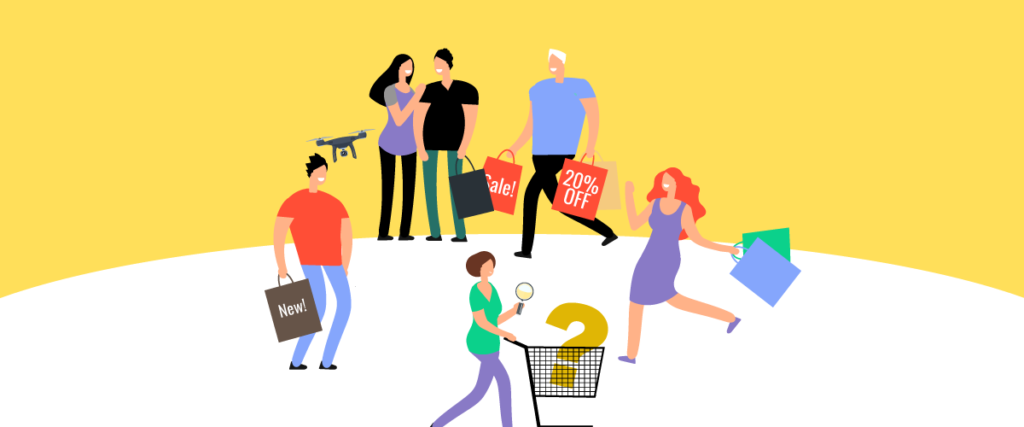Do you know what types of customers visit your eCommerce site?
Or what it takes to turn each type into buyers?
The truth is, customers come in a wide variety of types, and providing the same generic customer experience can damage your conversions, revenue, and brand perception.
What drives customer loyalty for one customer may stop another customer’s journey in its tracks.
Ideally, you want to provide every visitor a personal, individualized experience by remembering them, recognizing their preferences, and playing into their reason for visiting.
But how do you do that online?
Remembering individuals and their preferences is a solved problem on most eCommerce platforms thanks to cookies, but recognizing types of online shoppers and their level of buying intent? Not so much.
In this article, we’ll go over how understanding customer types can increase conversions, and the 5 types of customers that exist online, and how to identify, convert and track them.
Knowing the Types of Customers You Attract Is Crucial
The 5 Distinct Types of Customers & How to Convert Them
Identify and Serve Your Types of Customers
Knowing the Types of Customers You Attract Is Crucial
There are three main ways to segment customers so you can tailor marketing and sales efforts: demographics, psychographics, and behavioral. You might already be familiar with them, but let’s do a quick recap.
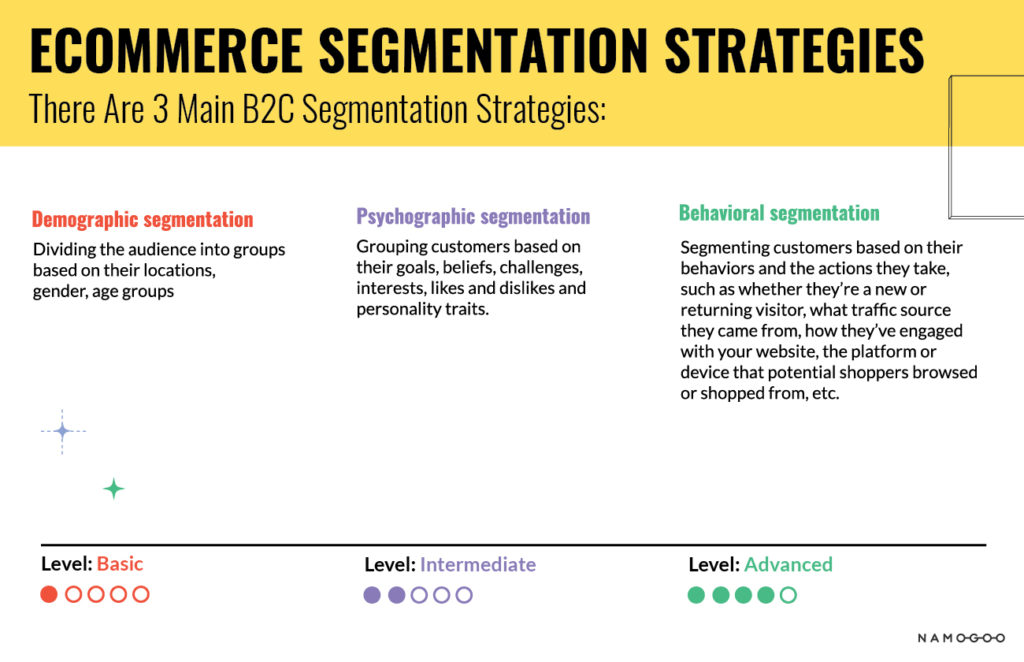
Demographic and psychographic segmentation help narrow your audience and segment them into groups based on how they might act, so you can target marketing spend to attract visitors most likely to convert.
The third, behavioral segmentation, uses data to narrow your audience based on what they actually do in real life, so you can anticipate what they need to move forward in the customer journey.
Combined with onsite behavioral analytics and intent prediction, you have a powerful blend to personalize the onsite promotions and overall experience, for example, with Namogoo’s Intent-Based Promotions.
But there’s more to consider.
Each segment you identify harbors different types of customers.
Let’s say you sell luxury watches, and your audience isn’t swayed by budget items. That doesn’t preclude them from being thrifters looking for the best deal.
Thrifters are just one type you may encounter in your store.
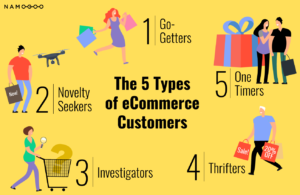
The five customer types are:
- Go-Getters
- Novelty-Seekers
- Investigators
- Thrifters
- One-Timer
Each customer type exhibits distinct buying behaviors, has varying informational needs, and wants a different type of customer experience.
Knowing which types of customers you attract, and which ones you don’t, makes it easier to fine-tune the customer experience, so you can:
- Maximize your revenue per visit (RPV) and average order value
- Optimize for same-session and future conversions
- Protect brand perception
- Drive average discounts down
- Improve the profitability of your eCommerce channel.
The 5 Distinct Types of Customers & How to Convert Them
Online shoppers generally fall into five different types, based on their online shopping habits. The first three patterns focus on the purpose of a visit to your site. The other two refine these further.

1. Go-Getters
Go-Getters know what they want and go straight for it.
They don’t linger, and they don’t look at other items in your store.
If they notice an item on sale, they won’t pay much attention. Any attempt to upsell or cross-sell with interstitials is an annoying interruption that gets in the way of completing their mission: purchasing an item they’ve already decided to buy.
Go-Getters often are return purchasers, restocking what they buy regularly.
Investigators (which we’ll cover below) can turn into Go-Getters once they’ve made their selection, but Go-Getters may have done their research offline, or act on someone’s recommendation.
Typical Onsite Behavior of Go-Getters
You know you’re dealing with Go-Getters when you see their signature sequence of events in your analytics data.
They go to the product via the shortest route possible, either going straight to the product page or entering on an arbitrary page and using your navigation or in-site search to locate the product.
Then, they put the product in a shopping cart, go through the checkout process, and leave.
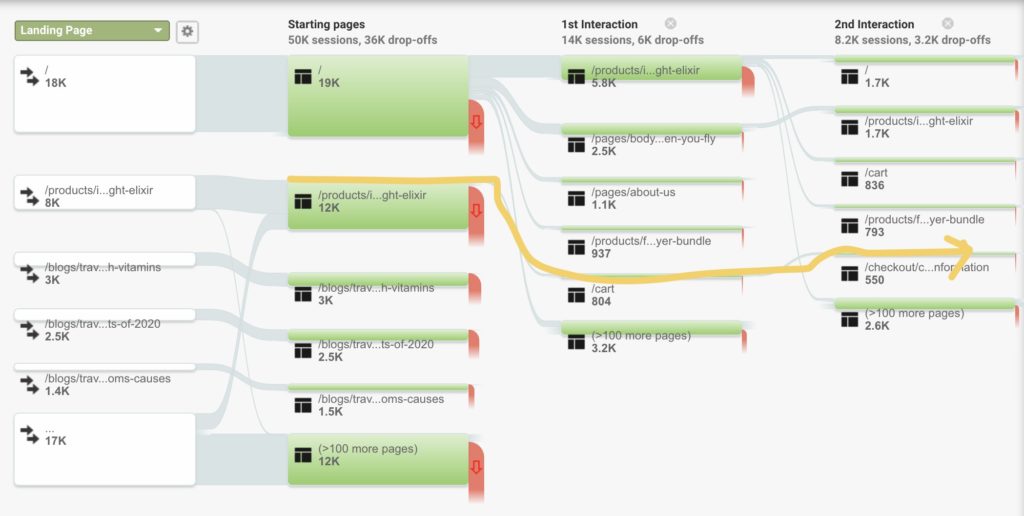
They’re regular users of quick-buy options like Amazon’s “Buy it again” feature.
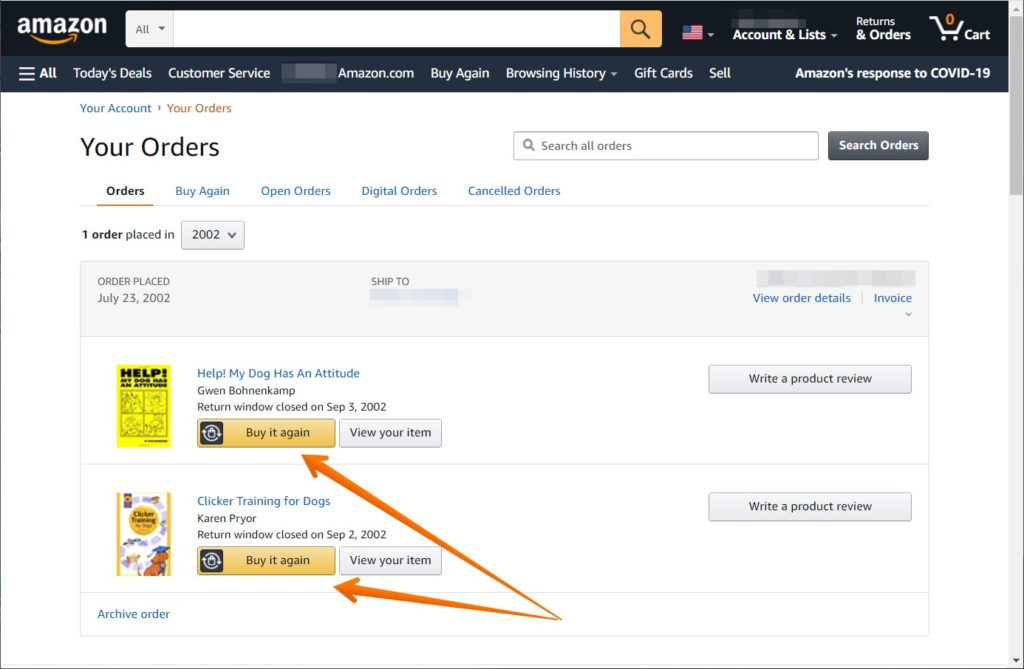
This online customer type has the shortest path to purchase of all.
How to Optimize the Customer Experience for Go-Getters
Turn Go-Getters into regulars by removing all friction.
- Invest in an intelligent search feature that lists only relevant products
- Make it easy to confirm they’ve located the right product with easy-to-read identifications, meaningful names, and detailed images
- Avoid pop-ups and interstitials that slow them down
- Remove or reduce upsells and cross-sells from your checkout process
- Ensure your checkout process is as fast as possible
- Make reordering easy
- Consider offering auto-ship on consumables
- To interest them in other products, use transactional emails to suggest related products
Relevant KPIs
- Time to purchase
- Cart and checkout abandonment rate
- Site speed, specifically checkout process
- Retention rate
- Customer lifetime value
- Email click-through rate on transactional emails.

2. Novelty-Seeker
Novelty-Seekers are in it for pleasure.
They linger, browse around, and enjoy looking for great finds.
They love to shop and to be in the know about the latest products. They crave novelty, seeking out what’s new and changed. Every new shiny object attracts their attention.
They don’t buy often, but they’re prone to impulse buying.
Don’t knock them, though. They aren’t shy about sharing their finds with their friends, and when they do buy, they’re easy to upsell and cross-sell.
Serve them well, and Novelty-Seekers can turn into your biggest fans and advocates, bringing in friends and followers.
Typical Onsite Behavior of Novelty-Seekers
Here are signs you have Novelty-Seekers in your customer segment:
- Low bounce rates
- High pages per visit
- High traffic on “what’s new” pages
- Sorting product lists by popularity (rather than relevance)
- High click-through rates on “people also bought” links and related or recommended products
- Low purchase conversion rates (per visit)
- High goal conversions on sharing products on social media or by email.
How to Optimize the Customer Experience for Novelty-Seekers
Turn Novelty-Seekers into buyers, fans, and advocates by making them feel good with a consistently excellent and convenient experience.
- Turn them into regular visitors with easy access to the latest, the most popular, the top-selling, and of course, the fabulous finds (cool products on sale)
- Put sharing buttons for the major social media sites within easy reach and populate the message
- Offer lists of related and recommended products
- Upsell them with “also looked at” lists
- Cross-sell them with “people who bought this, also …” lists
- Optimize your site and images for speed so as not to slow them down
- Offer a newsletter and notifications of “new arrivals”
- Reduce your checkout process to the bare necessities; don’t interrupt an impulse buy
- Offer a referral program
Relevant KPIs
- Onsite activity metrics:
- Time on site
- Pages per session
- Unique visitors vs pageviews (return visits)
- Customer engagement (reactions, shares, email subscriptions)
- Social media engagement (followers, reactions, shares)
- Products added to wishlist
- Refund and return rate
- Site speed
- Average referral rate
- Referral conversion rate
3. Investigator
Investigators have a purchase in mind, for example, a printer or a coat, but they haven’t yet settled on which product to purchase.
Making an informed choice drives their behavior.
Investigators devour product reviews, seek out recommendations and comparative reviews by experts, research advantages and disadvantages, and compare features and prices at length.
They may take a while to make up their minds, but they turn into Go-Getters once they do.
Typical Onsite Behavior of Investigators
Investigators leave tell-tale signs in your analytics.
They resemble Novelty-Seekers in:
- Low bounce rates
- High pages per visit
- Low purchase conversion rates (per visit)
But they distinguish themselves by:
- Focusing on a single type of product (or a limited set of highly related ones)
- Spending time on review pages
- Coming back to the same product pages, often over several visits
- Sorting product lists by review stars or price
- Methodically visiting every product in a category or searching for products of a specific type.
How to Optimize the Customer Experience for Investigators
Turn Investigators into loyal fans by quenching their thirst for knowledge and becoming their go-to source for product information and easy comparisons.
- Use consistent product information across a product category, such as charts or ordered lists
- Help narrow candidates with elastic search options and customizing the options for each product category
- Facilitate product selection with easy category-specific comparisons and an option to show only the differences between products
- Alleviate choice overload with “<your shop>’s choice” ribbons on product images
- Build a knowledge base with explanations of product terminology and why they would care about it
- Put explanations “at their fingertips” without overwhelming other visitors, for example, a short explanation “on hover” with a link to more details
- Create buyer’s guides
- Offer a “favorites” feature or let your shopping cart do double duty by keeping items across visits and allowing easy modification
- Offer user reviews, and take a page out of Amazon’s book with a “verified purchase” tag to raise trust in reviews
- Write your own comparative product reviews
Relevant KPIs
- Onsite activity metrics
- Time on site
- Time on page, in-page navigation (tabs and sections)
- Pages per session
- Unique visitors vs pageviews (return visits)
- Products added to wishlist
- Product comparisons executed
- User reviews
- Knowledgebase and blog views
- Site speed
4. Thrifter
Thrifters want the best deal.
They need to feel like they’re saving money or getting a better value.
They’ll even spend more to qualify for a discount or another “saving,” such as free shipping, overnight delivery, and complimentary gifts. But they’ll bolt as soon as they spot a better deal elsewhere.
Don’t discount them; a whopping 67% of shoppers are Thrifters.
You’ll find them amongst Go-Getters, Novelty-Seekers, and Investigators alike, and they can also be One-Timers.
Typical Onsite Behavior of Thrifters
Signs of Thrifters in your store’s analytics include:
- High bounce rates on product pages when the products are not on sale, high conversion rates when they are
- Many carts just over the qualifying threshold for a free perk — a gift, free shipping, etc.
- Reordering products only when those products are discounted
- Higher than normal order quantities when a product is on sale
- Purchases consisting mostly — and even solely — of discounted items.
How to Optimize the Customer Experience for Thrifters
Turn Thrifters into repeat customers by convincing them you’ll always give them the best deal they can find.
- Flaunt items on sale, but mix them in with full-price items to draw attention to them
- Have an easy-to-find “sale” section
- Drive home the savings by showing the regular and the discounted price and how much they save both as an amount and a percentage
- Offer coupons and discount codes for handing over their email address and send new ones in a regular newsletter
- Make it easy to enter discount codes in your checkout process
- List your promotions and discount codes to keep them on page (Consider using pop-ups or banners to highlight discount codes and deals)
- Apply discounts automatically, for example, drop shipping costs to zero when a cart’s value qualifies for free shipping
- Lead with benefits in product descriptions to give them other reasons to shop with you and become loyal returning customers
Relevant KPIs
- Customer acquisition cost
- Average order value (in relation to promotion qualifying criteria)
- Cart composition (discounted versus full-price items)
- Average profit margin
5. One-Timer
One-Timers are on a mission to fulfill a one-time need.
They may be looking to buy a gift, spend a gift card or gifted money, help someone out, or make a large purchase they’ll only buy once.
You’ll find them amongst all other types, and they can be Thrifters, too.
What sets them apart is their unfamiliarity with your brand, site, and products. They often have no idea what to get — not even a category, and no intention of returning after fulfilling their mission.
They’ll browse around to familiarize themselves with your products and may hone in on a price range set by their available budget.
Any trouble navigating your site or finding a product they like can send them packing. Forcing them to create an account to complete a purchase can do that, too.
Typical Onsite Behavior of One-Timers
Analytics signs of One-Timers on your site include:
- Using structured navigation
- Browsing several product categories, often within a specific price range
- Abandoning carts at the point where you get shoppers to create an account
- Visiting pages about your company and shop.
Most of the time, though, you’ll only know you were dealing with a One-Timer after the fact — when they don’t return.
How to Optimize the Customer Experience for One-Timers
Giving One-Timers a smooth experience is your best bet for making a sale now (instead of losing them to the competition), and getting them to return later.
- Offer a “guest” checkout — ordering without creating an account
- Help them figure out what to buy with easy to understand product categories and clear product descriptions and images
- Include price ranges in your elastic search filtering and keep the setting when they switch categories
- Create an easy to navigate information and site architecture
- Consider flexible or lenient return policies to alleviate uncertainty around buying gifts for other people
- Invest in trust signals:
- Easy-to-find company and full contact information
- Store ratings and reviews, preferably through one or more independent agencies
- Membership of and certification by consumer protection associations
Relevant KPIs
- Cart and checkout abandonment rate
- Refund and return rate
- Bounce rate
- Products added to wishlist
- If you don’t offer a wishlist or favorites feature, cart abandonment may be high because it’s used to collect items of interest.
Identify and Serve Your Types of Customers
It’s your turn now — time to personalize your shopper’s experience.
Find out what types of customers are visiting your online store, and enhance their experience so they’ll remember you fondly and return for more.
For real-time, individual customization, be sure to check out how Namogoo’s Intent Based Promotions help you optimize your promotions budget.
Do you know what types of customers visit your eCommerce site?
Or what it takes to turn each type into buyers?
The truth is, customers come in a wide variety of types, and providing the same generic customer experience can damage your conversions, revenue, and brand perception.
What drives customer loyalty for one customer may stop another customer’s journey in its tracks.
Ideally, you want to provide every visitor a personal, individualized experience by remembering them, recognizing their preferences, and playing into their reason for visiting.
But how do you do that online?
Remembering individuals and their preferences is a solved problem on most eCommerce platforms thanks to cookies, but recognizing types of online shoppers and their level of buying intent? Not so much.
In this article, we’ll go over how understanding customer types can increase conversions, and the 5 types of customers that exist online, and how to identify, convert and track them.
Knowing the Types of Customers You Attract Is Crucial
The 5 Distinct Types of Customers & How to Convert Them
Identify and Serve Your Types of Customers
Knowing the Types of Customers You Attract Is Crucial
There are three main ways to segment customers so you can tailor marketing and sales efforts: demographics, psychographics, and behavioral. You might already be familiar with them, but let’s do a quick recap.

Demographic and psychographic segmentation help narrow your audience and segment them into groups based on how they might act, so you can target marketing spend to attract visitors most likely to convert.
The third, behavioral segmentation, uses data to narrow your audience based on what they actually do in real life, so you can anticipate what they need to move forward in the customer journey.
Combined with onsite behavioral analytics and intent prediction, you have a powerful blend to personalize the onsite promotions and overall experience, for example, with Namogoo’s Intent-Based Promotions.
But there’s more to consider.
Each segment you identify harbors different types of customers.
Let’s say you sell luxury watches, and your audience isn’t swayed by budget items. That doesn’t preclude them from being thrifters looking for the best deal.
Thrifters are just one type you may encounter in your store.

The five customer types are:
- Go-Getters
- Novelty-Seekers
- Investigators
- Thrifters
- One-Timer
Each customer type exhibits distinct buying behaviors, has varying informational needs, and wants a different type of customer experience.
Knowing which types of customers you attract, and which ones you don’t, makes it easier to fine-tune the customer experience, so you can:
- Maximize your revenue per visit (RPV) and average order value
- Optimize for same-session and future conversions
- Protect brand perception
- Drive average discounts down
- Improve the profitability of your eCommerce channel.
The 5 Distinct Types of Customers & How to Convert Them
Online shoppers generally fall into five different types, based on their online shopping habits. The first three patterns focus on the purpose of a visit to your site. The other two refine these further.

1. Go-Getters
Go-Getters know what they want and go straight for it.
They don’t linger, and they don’t look at other items in your store.
If they notice an item on sale, they won’t pay much attention. Any attempt to upsell or cross-sell with interstitials is an annoying interruption that gets in the way of completing their mission: purchasing an item they’ve already decided to buy.
Go-Getters often are return purchasers, restocking what they buy regularly.
Investigators (which we’ll cover below) can turn into Go-Getters once they’ve made their selection, but Go-Getters may have done their research offline, or act on someone’s recommendation.
Typical Onsite Behavior of Go-Getters
You know you’re dealing with Go-Getters when you see their signature sequence of events in your analytics data.
They go to the product via the shortest route possible, either going straight to the product page or entering on an arbitrary page and using your navigation or in-site search to locate the product.
Then, they put the product in a shopping cart, go through the checkout process, and leave.

They’re regular users of quick-buy options like Amazon’s “Buy it again” feature.

This online customer type has the shortest path to purchase of all.
How to Optimize the Customer Experience for Go-Getters
Turn Go-Getters into regulars by removing all friction.
- Invest in an intelligent search feature that lists only relevant products
- Make it easy to confirm they’ve located the right product with easy-to-read identifications, meaningful names, and detailed images
- Avoid pop-ups and interstitials that slow them down
- Remove or reduce upsells and cross-sells from your checkout process
- Ensure your checkout process is as fast as possible
- Make reordering easy
- Consider offering auto-ship on consumables
- To interest them in other products, use transactional emails to suggest related products
Relevant KPIs
- Time to purchase
- Cart and checkout abandonment rate
- Site speed, specifically checkout process
- Retention rate
- Customer lifetime value
- Email click-through rate on transactional emails.

2. Novelty-Seeker
Novelty-Seekers are in it for pleasure.
They linger, browse around, and enjoy looking for great finds.
They love to shop and to be in the know about the latest products. They crave novelty, seeking out what’s new and changed. Every new shiny object attracts their attention.
They don’t buy often, but they’re prone to impulse buying.
Don’t knock them, though. They aren’t shy about sharing their finds with their friends, and when they do buy, they’re easy to upsell and cross-sell.
Serve them well, and Novelty-Seekers can turn into your biggest fans and advocates, bringing in friends and followers.
Typical Onsite Behavior of Novelty-Seekers
Here are signs you have Novelty-Seekers in your customer segment:
- Low bounce rates
- High pages per visit
- High traffic on “what’s new” pages
- Sorting product lists by popularity (rather than relevance)
- High click-through rates on “people also bought” links and related or recommended products
- Low purchase conversion rates (per visit)
- High goal conversions on sharing products on social media or by email.
How to Optimize the Customer Experience for Novelty-Seekers
Turn Novelty-Seekers into buyers, fans, and advocates by making them feel good with a consistently excellent and convenient experience.
- Turn them into regular visitors with easy access to the latest, the most popular, the top-selling, and of course, the fabulous finds (cool products on sale)
- Put sharing buttons for the major social media sites within easy reach and populate the message
- Offer lists of related and recommended products
- Upsell them with “also looked at” lists
- Cross-sell them with “people who bought this, also …” lists
- Optimize your site and images for speed so as not to slow them down
- Offer a newsletter and notifications of “new arrivals”
- Reduce your checkout process to the bare necessities; don’t interrupt an impulse buy
- Offer a referral program
Relevant KPIs
- Onsite activity metrics:
- Time on site
- Pages per session
- Unique visitors vs pageviews (return visits)
- Customer engagement (reactions, shares, email subscriptions)
- Social media engagement (followers, reactions, shares)
- Products added to wishlist
- Refund and return rate
- Site speed
- Average referral rate
- Referral conversion rate
3. Investigator
Investigators have a purchase in mind, for example, a printer or a coat, but they haven’t yet settled on which product to purchase.
Making an informed choice drives their behavior.
Investigators devour product reviews, seek out recommendations and comparative reviews by experts, research advantages and disadvantages, and compare features and prices at length.
They may take a while to make up their minds, but they turn into Go-Getters once they do.
Typical Onsite Behavior of Investigators
Investigators leave tell-tale signs in your analytics.
They resemble Novelty-Seekers in:
- Low bounce rates
- High pages per visit
- Low purchase conversion rates (per visit)
But they distinguish themselves by:
- Focusing on a single type of product (or a limited set of highly related ones)
- Spending time on review pages
- Coming back to the same product pages, often over several visits
- Sorting product lists by review stars or price
- Methodically visiting every product in a category or searching for products of a specific type.
How to Optimize the Customer Experience for Investigators
Turn Investigators into loyal fans by quenching their thirst for knowledge and becoming their go-to source for product information and easy comparisons.
- Use consistent product information across a product category, such as charts or ordered lists
- Help narrow candidates with elastic search options and customizing the options for each product category
- Facilitate product selection with easy category-specific comparisons and an option to show only the differences between products
- Alleviate choice overload with “<your shop>’s choice” ribbons on product images
- Build a knowledge base with explanations of product terminology and why they would care about it
- Put explanations “at their fingertips” without overwhelming other visitors, for example, a short explanation “on hover” with a link to more details
- Create buyer’s guides
- Offer a “favorites” feature or let your shopping cart do double duty by keeping items across visits and allowing easy modification
- Offer user reviews, and take a page out of Amazon’s book with a “verified purchase” tag to raise trust in reviews
- Write your own comparative product reviews
Relevant KPIs
- Onsite activity metrics
- Time on site
- Time on page, in-page navigation (tabs and sections)
- Pages per session
- Unique visitors vs pageviews (return visits)
- Products added to wishlist
- Product comparisons executed
- User reviews
- Knowledgebase and blog views
- Site speed
4. Thrifter
Thrifters want the best deal.
They need to feel like they’re saving money or getting a better value.
They’ll even spend more to qualify for a discount or another “saving,” such as free shipping, overnight delivery, and complimentary gifts. But they’ll bolt as soon as they spot a better deal elsewhere.
Don’t discount them; a whopping 67% of shoppers are Thrifters.
You’ll find them amongst Go-Getters, Novelty-Seekers, and Investigators alike, and they can also be One-Timers.
Typical Onsite Behavior of Thrifters
Signs of Thrifters in your store’s analytics include:
- High bounce rates on product pages when the products are not on sale, high conversion rates when they are
- Many carts just over the qualifying threshold for a free perk — a gift, free shipping, etc.
- Reordering products only when those products are discounted
- Higher than normal order quantities when a product is on sale
- Purchases consisting mostly — and even solely — of discounted items.
How to Optimize the Customer Experience for Thrifters
Turn Thrifters into repeat customers by convincing them you’ll always give them the best deal they can find.
- Flaunt items on sale, but mix them in with full-price items to draw attention to them
- Have an easy-to-find “sale” section
- Drive home the savings by showing the regular and the discounted price and how much they save both as an amount and a percentage
- Offer coupons and discount codes for handing over their email address and send new ones in a regular newsletter
- Make it easy to enter discount codes in your checkout process
- List your promotions and discount codes to keep them on page (Consider using pop-ups or banners to highlight discount codes and deals)
- Apply discounts automatically, for example, drop shipping costs to zero when a cart’s value qualifies for free shipping
- Lead with benefits in product descriptions to give them other reasons to shop with you and become loyal returning customers
Relevant KPIs
- Customer acquisition cost
- Average order value (in relation to promotion qualifying criteria)
- Cart composition (discounted versus full-price items)
- Average profit margin
5. One-Timer
One-Timers are on a mission to fulfill a one-time need.
They may be looking to buy a gift, spend a gift card or gifted money, help someone out, or make a large purchase they’ll only buy once.
You’ll find them amongst all other types, and they can be Thrifters, too.
What sets them apart is their unfamiliarity with your brand, site, and products. They often have no idea what to get — not even a category, and no intention of returning after fulfilling their mission.
They’ll browse around to familiarize themselves with your products and may hone in on a price range set by their available budget.
Any trouble navigating your site or finding a product they like can send them packing. Forcing them to create an account to complete a purchase can do that, too.
Typical Onsite Behavior of One-Timers
Analytics signs of One-Timers on your site include:
- Using structured navigation
- Browsing several product categories, often within a specific price range
- Abandoning carts at the point where you get shoppers to create an account
- Visiting pages about your company and shop.
Most of the time, though, you’ll only know you were dealing with a One-Timer after the fact — when they don’t return.
How to Optimize the Customer Experience for One-Timers
Giving One-Timers a smooth experience is your best bet for making a sale now (instead of losing them to the competition), and getting them to return later.
- Offer a “guest” checkout — ordering without creating an account
- Help them figure out what to buy with easy to understand product categories and clear product descriptions and images
- Include price ranges in your elastic search filtering and keep the setting when they switch categories
- Create an easy to navigate information and site architecture
- Consider flexible or lenient return policies to alleviate uncertainty around buying gifts for other people
- Invest in trust signals:
- Easy-to-find company and full contact information
- Store ratings and reviews, preferably through one or more independent agencies
- Membership of and certification by consumer protection associations
Relevant KPIs
- Cart and checkout abandonment rate
- Refund and return rate
- Bounce rate
- Products added to wishlist
- If you don’t offer a wishlist or favorites feature, cart abandonment may be high because it’s used to collect items of interest.
Identify and Serve Your Types of Customers
It’s your turn now — time to personalize your shopper’s experience.
Find out what types of customers are visiting your online store, and enhance their experience so they’ll remember you fondly and return for more.
For real-time, individual customization, be sure to check out how Namogoo’s Intent Based Promotions help you optimize your promotions budget.



